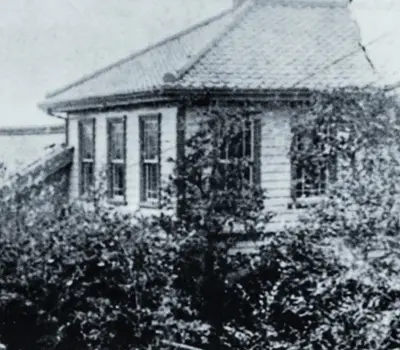Today, Daiichi Sankyo Co., Ltd. (Daiichi Sankyo) has two R&D centers in Tokyo. One of them, the Kasai R&D Center, originated from the Funabori plant of Daiichi Pharmaceutical Co., Ltd. (Daiichi). Of Daiichi’s multiple plants, the Funabori plant had a history full of twists and turns before ultimately becoming the Kasai R&D Center. For the history of the Shinagawa R&D research facility, click here.
Taking on the challenge of the domestic production of the syphilis treatment, Salvarsan

Daiichi's Yanagishima plant, which was first established
by Arsemin Shokai
Daiichi first began its pharmaceutical operations at its Yanagishima Plant, which was established under the company name, “Arsemin Shokai,” prior to Daiichi becoming a joint-stock company (for that story, click here). The plant was originally utilized as a facility for the production of Salvarsan, a treatment for syphilis that Dr. Shozaemon Keimatsu succeeded in test-producing for commercialization in 1915.
Initially, the Yanagishima plant was a small workshop built on land leased from Tsuyoru Shokai, a company run by Tsunekichi Sakakibara, a friend of Dr. Keimatsu and a collaborator in the production of Salvarsan. Following the popularity of Neo-Neo-Arsemin, Salvarsan’s brand name, which was developed at the end of 1916, and the relocation of Tsuyoru Shokai factory in 1917, Arsemin Shokai was able to operate independently. The Yanagishima plant was expanded with the construction of a new two-story wooden factory and brick warehouse.
In 1918, when Daiichi Pharmaceutical was established, it began to manufacture industrial chemicals. The Yanagishima plant continued to expand, at one stage tripling its production capacity and developing new drugs, such as Bosmin. However, on September 1, 1923, the Great Kanto Earthquake struck, and both the plant and the Daiichi Pharmaceutical headquarters suffered severe damage. A temporary office was immediately established, and by the beginning of the following year, the construction of a new office, which was also used as warehouse and dormitory, was completed and almost all employees returned to work. However, less than three years later, due to zoning changes in 1926, the company had to reduce the plant site size and relocate the head office.
In response to increased wartime demand, a succession of plants was established
To continue meeting the demand for pharmaceuticals, the company could not afford to reduce its manufacturing capacity. Therefore, in 1929, the company acquired land in Kameido-machi, Minami-katsushika-gun (present-day northeast part of Koto-ku, Tokyo), at the location of a factory of Koto Seiyaku K.K. (another company run by Mr. Sakakibara) and established the Kameido plant. The company manufactured Albalite, a dye-extracting agent, and hydrosulfite, a bleaching agent, which had previously been manufactured at the Yanagishima plant.
Nevertheless, the three plants in Yanagishima, Kameido, and Kyoto were unable to meet the growing demand for domestically produced pharmaceuticals. To address this situation, the Funabori plant was established in 1938 in Minami Funabori-cho, Edogawa-ku, Tokyo. With additional locations where industrial chemicals, mainly hydrosulfites, were manufactured, production capacity increased, and new products, such as sleeping pills, were developed.
In the following years, the demand for pharmaceuticals continued unabated. In 1942, the company took over a plant scheduled for closure in Hirai, Edogawa-ku, and established the Hirai plant to manufacture sodium sulfite and sleeping pills, which had been produced at the original plant. The following year, the company expanded its business by evacuating and incorporating plants of merged companies and taking over the manufacturing of raw material chemicals.
Despite Wartime Damage, Daiichi was revived mainly by the Funabori plant
The company continued to grow steadily; however, the situation changed drastically in 1945. In the course of air raids at that time, the company suffered a severe blow: the head office, 80% of the Yanagishima plant, and half of the Hirai plant, including the main part, were destroyed by fire, and only one building was left of the Kameido plant.
Fortunately, the vault in the basement of the head office, which contained banknotes, share certificates and other important contracts, among other items, remained intact, and the Funabori plant, which was the largest in terms of facilities and scale, miraculously escaped damage. Therefore, the Funabori plant was used as the base for rebuilding the production lines. Despite facing a shortage of raw materials and price hikes caused by post-war inflation, by 1946, the company resumed the production of hydrosulfite and other products. Subsequently, the company even cultivated its own digitalis, a key raw material, and launched the cardiotonic agent “Adistin.”
The Kameido plant, which suffered the most damage, was later closed, partly due to greenery revitalization projects in the area; however, the Yanagishima and Hirai plants were reopened and successfully revived.
Even in the face of adversity, Daiichi has dedicated itself to contributing to public health, a passion and drive which continue to live on within Daiichi Sankyo to this day.